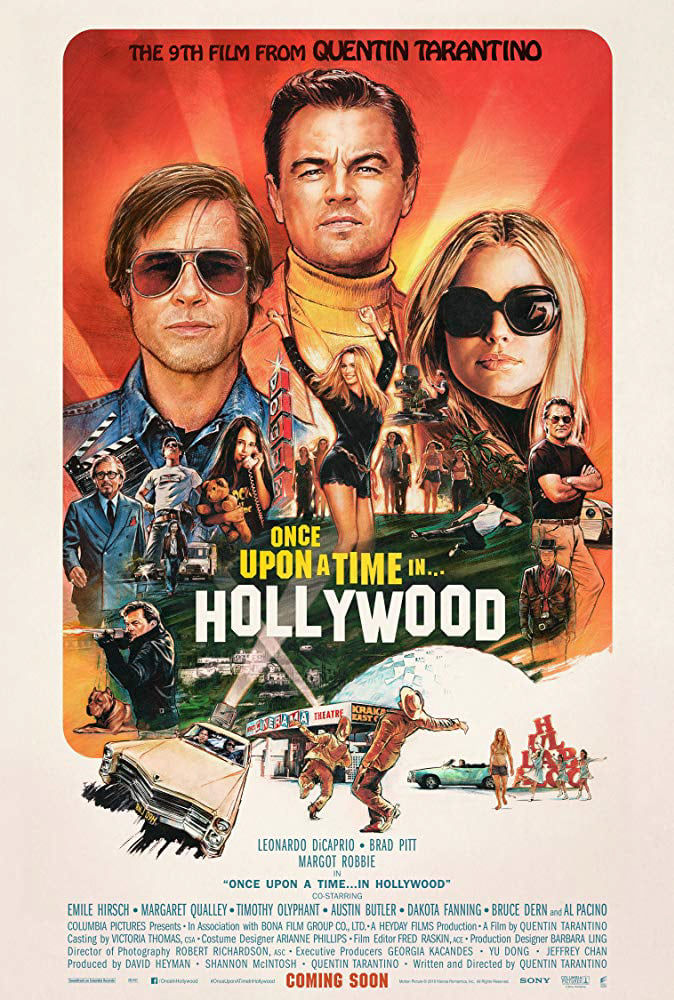When my old man’s birthday finally rolled around this year, taking him out to see a horrifically gory movie may have been one of my more prominent lapses in judgment (and trust me, I’m not scarce for those). Our decision to see the newest film by Quentin Tarantino, “Once Upon a Time in Hollywood,” was surpassed only in its amount of flinch-inducing moments by my sister taking our mom out to see “Black Swan.” This ninth film by Tarantino (of which there will ostensibly be only one more), tells the tale of actor Rick Dalton (Leonardo DiCaprio), who’s on the verge of washing up, and his loyal stunt double Cliff Booth (Brad Pitt). The two stories begin to merge into one when actress Sharon Tate (Margot Robbie) and her husband and director Roman Polanski move in next door, sending the Hollywood stars spiraling towards their eventual grotesque encounter with Charles Manson and his minions.
Honestly, I should’ve known better — a Tarantino film involving Charles Manson is, of course, going to be egregiously bloody. Being a Tarantino fan, this hardly marred my overall perception of “Once Upon a Time,” but I couldn’t help but notice that it was lacking in other certain qualities. No matter how much chaos and mayhem there may be, it couldn’t quite make up for what feels like a lack of Tarantino’s usual pizzazz (the un-bloody parts, anyway). It’s certainly not Tarantino’s worst film; just not his best either.
“Once Upon A Time” has all the makings of Tarantino’s normal flicks — idiosyncratic characters and generous genre-meshing — but something feels off, like the pieces of the puzzle didn’t quite fit and instead were jammed together in an overly long movie. Perhaps that’s what makes the end of the film both so jarring yet relieving — relieving in the sense that you’ll think, “Oh yeah, this is a Tarantino film!” and jarring in the sense that you’ll realize “Oh yeah, this is a Tarantino film?” There’s about an hour-long lull smack-dab in the center of the film, deprived of the normal personality and extravagance one gets used to with Tarantino, and one that was present at the beginning and end of the film. The most successful scenes of the movie are when he’s in his element: quirky, black-and-white flashbacks interspersed with dialogue, or a gritty Western-style brawl that takes place … on the set of a Western.
However, the most scene-stealing parts of the movie came from a few Tarantino veterans. In true Western parlance, this ain’t their first rodeo, and it shows in the performance of DiCaprio, Pitt, and Robbie. DiCaprio plays the frustrated actor maybe a little too well, and Brad Pitt plays … Brad Pitt. Not that that’s a bad thing; he’s getting pretty good at it. Regarding Margot Robbie, there was quite a bit of controversy surrounding her: a) her portrayal of a murdered actress, and b) her paltry number of spoken lines that Tarantino gave her. In both aspects, Margot Robbie came out on top. With the screen time that she was given, she paints a picture of the serenely innocent Sharon Tate, a refreshing, ever-sweet presence compared to DiCaprio’s angsty Dalton and Pitt’s brash Booth.
If you know anything about Hollywood in the 1960’s and the infamous “Helter Skelter” incident, you might be bracing yourself for the inevitable end of the story. I sure was, having grown so attached to Robbie’s Tate. I don’t want to spoil much, but I’ll just say this: the ending, a la “Inglourious Basterds,” leaves no illusion as to why the movie is titled “Once Upon a Time.” After over two and a half hours of runtime (a bit too long; a feat of endurance and heaps of popcorn), the finale is a fantasy you’ll be thinking about long after walking out of the theater. It’s really the ending that lends the film the brunt of its strength. For Tarantino’s penultimate film, he definitely could’ve done worse — it’s just that this won’t quite stand up to the giants that “Pulp Fiction” and “Kill Bill” are. According to Quentin himself, a director only has ten good films in him, and hopefully that continues to hold true for the next one.
Contact Hannah Blum at hannahbl ‘at’ stanford.edu.
